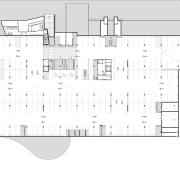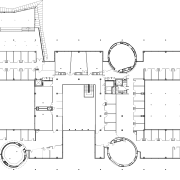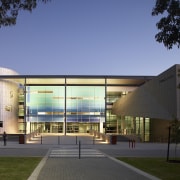OUtside the square
Teaching spaces in the University of Western Australia's new Business School are contained within dramatic cylindrical forms, but just as much space is given to the informal learning environment
Just as tertiary education has become a lot more student focused than in the past, so is the design of our universities evolving to meet changing needs.
The University of Western Australia's new Business School, on the Crawley Campus, was designed to provide the flexible and innovative learning environment now demanded on both a national and international level. But it was also designed to provide a new gateway to the university on its southern boundary.
Architect Michael Michelides of Woods Bagot says the Business School, which brings together undergraduate and postgraduate faculties, needed to respect the original 1930s sandstone buildings on the northern side of the campus.
"The building not only had to make a distinctive contribution to the identity of the university's southern entrance, it also had to play a part in forming a significant landscape," he says. "At the same time, it was important to develop a contemporary architectural language that would set the benchmark for future developments on campus."
Michelides says the design team took their cue from the state's economic history.
"The architectural expression is derived from images associated with this history. The business and economics of Western Australia are primarily founded on agriculture and mineral resources. These industries have changed the landscape and the hinterland of the state. We abstracted images from aerial photographs of the gold fields, wheat belt, Pilbara, Kimberley and the Southwest, and developed a series of patterns that we could then apply to materials, colours, finishes and shapes. For example, there are organic-shaped cut-outs that reference the salt lakes, and more angular shapes taken from the agricultural landscape."
The colours can also be attributed to the wider surroundings the graduated shades of blue glass on the front of the building acknowledge Perth's proximity to the Indian Ocean. And the use of three different types of metal cladding copper, zinc and aluminium is a link to Western Australia's mining industry.

Other materials directly reference the heritage buildings on campus. The building is bookended on the east and west corners by solid walls clad in long, extruded terracotta tiles.
"Terracotta features on the roofing of the original university buildings," says Michelides. "We wanted to acknowledge this, but use the material in a more contemporary way. The terracotta walls also help reduce heat gain on the eastern and western walls."
On a larger scale, the use of varying materials and shapes defines different functions within the Business School. The 350-seat lecture theatre is accommodated within the folded planes of a zinc-panelled pavilion, while teaching spaces, case-study rooms and faculty rooms are housed in cylindrical elements known as "knowledge vessels".
"The most important architectural expressions accommodate the key learning environments," says Michelides. "These elements have been treated as strong sculptural forms that explore a variety of cladding materials. The cylindrical forms are also a counterpoint to the rectilinear form of the building."
To articulate the identity of these sculptural elements, each form is physically separated from the main building the cylinders appear to punch through the canopy. And a large awning above an east-facing courtyard floats between the buildings, supported by a group of nine slender columns.
The heart of the school is a three-storey atrium, which is a central gathering place for students and staff.
"In recent years there has been a fundamental shift in the pedagogy framework for tertiary education," says Michelides. "Today learning is more student centred. It takes place in teams, across disciplines and outside the classroom. There is a need for social breakout spaces adjacent to the more formal learning areas, and greater flexibility in the configuration of spaces."

Casual meeting areas, breakout spaces, a student commons and a 150-seat cafeteria are positioned around the atrium on the upper two floors. Open stairwells increase the opportunities for social interaction.
"Students and staff are encouraged to stay and use the facilities after the formal teaching sessions, which is precisely what is happening," says the architect.
To achieve these facilities within the budget, Michelides says the company commissioned a utilisation study and consequently reworked the accommodation schedule.
"We were able to reduce the size of the lecture theatres and classrooms, making significant savings that then allowed us to increase the size of the casual meeting areas."
Sustainability was another key driver for the design, with passive solar design principles employed. Glazing features on the north and south walls aerofoil-profile aluminium louvres shade the north from autumn to spring, while the east and west facades are clad in the terracotta tiles. Narrow extruded terracotta louvres, which line up with the tile joints, help screen the corner windows from the sun.
Michelides says the company introduced an energy-efficient chilled beam air conditioning system. Although such a system was not included in the budget, the design team was able to make construction savings by reducing the overall building height. This provided funding for the chilled beam technology, which, due to a decreased requirement for ceiling space, made the reduced building height possible.
This technology will provide considerable ongoing energy savings. And because the air is not recycled, it is also a healthy option, which fits perfectly with the Business School's desire to provide a holistic learning environment for students and staff.
Credit list
Architect and interior designer
Civil engineer
Mechanical, hydraulics and electrical engineer
Fire consultant
Cladding
Curtain wall
Balconies and balustrades
Flooring
Paints
Heating and air conditioning
Security system
Lift services
Construction company
Structural engineer
Quantity surveyor
Landscaping
Roofing
Hardware
Columns
Wallcoverings
Lighting
Public area furniture
Signage
Story by: Colleen Hawkes
Home kitchen bathroom commercial design
Diving into nature
Classic looks, contemporary efficiency
Personality plus














